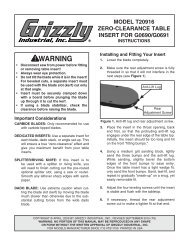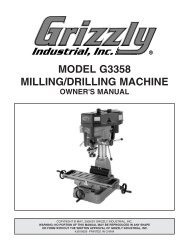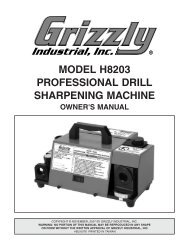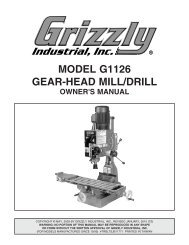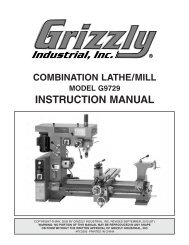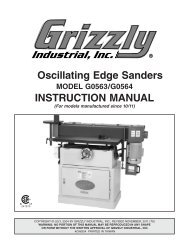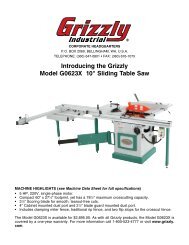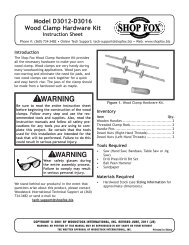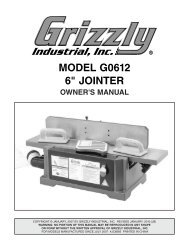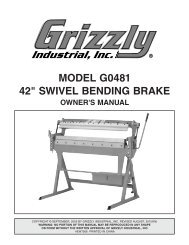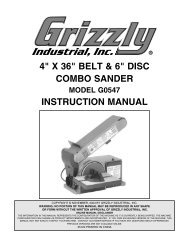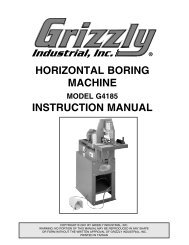Create successful ePaper yourself
Turn your PDF publications into a flip-book with our unique Google optimized e-Paper software.
COMBINATION SANDER<br />
MODEL <strong>G1013</strong><br />
INSTRUCTION MANUAL<br />
COPYRIGHT © 1991 BY GRIZZLY INDUSTRIAL, INC.<br />
WARNING: NO PORTION OF THIS MANUAL MAY BE REPRODUCED IN ANY SHAPE<br />
OR FORM WITHOUT THE WRITTEN APPROVAL OF GRIZZLY INDUSTRIAL, INC.<br />
REVISED FEBRUARY, 2002. PRINTED IN TAIWAN<br />
ONLINE MANUAL DISCLAIMER<br />
THE INFORMATION IN THIS MANUAL REPRESENTS THE CONFIGURATION OF THE MACHINE AS IT IS CURRENTLY BEING SHIPPED. THE<br />
MACHINE CONFIGURATION CAN CHANGE AS PRODUCT IMPROVEMENTS ARE INCORPORATED. IF YOU OWN AN EARLIER VERSION OF THE<br />
MACHINE, THIS MANUAL MAY NOT EXACTLY DEPICT YOUR MACHINE. CONTACT CUSTOMER SERVICE IF YOU HAVE ANY QUESTIONS<br />
ABOUT DIFFERENCES. PREVIOUS VERSIONS ARE NOT AVAILABLE ONLINE.
WARNING<br />
Some dust created by power sanding, sawing, grinding,<br />
drilling, and other construction activities contains<br />
chemicals known to the State of California to cause<br />
cancer, birth defects or other reproductive harm.<br />
Some examples of these chemicals are:<br />
• Lead from lead-based paints.<br />
• Crystalline silica from bricks, cement, and<br />
other masonry products.<br />
• Arsenic and chromium from chemically treated<br />
lumber.<br />
Your risk from these exposures varies, depending on<br />
how often you do this type of work. To reduce your<br />
exposure to these chemicals: work in a well ventilated<br />
area, and work with approved safety equipment, such<br />
as those dust masks that are specially designed to filter<br />
out microscopic particles.
Table Of Contents<br />
PAGE<br />
1. SAFETY<br />
SAFETY INSTRUCTIONS FOR POWER TOOLS ................................................2-3<br />
ADDITIONAL SAFETY INSTRUCTIONS FOR SANDERS ......................................4<br />
2. CIRCUIT REQUIREMENTS<br />
110V OPERATION ....................................................................................................5<br />
FUSING ....................................................................................................................5<br />
EXTENSION CORDS ................................................................................................5<br />
GROUNDING ............................................................................................................5<br />
3. INTRODUCTION<br />
COMMENTARY ........................................................................................................6<br />
UNPACKING..............................................................................................................7<br />
PARTS INVENTORY ................................................................................................8<br />
CLEAN UP ................................................................................................................9<br />
SITE CONSIDERATIONS ........................................................................................9<br />
4. ASSEMBLY<br />
OVERVIEW..............................................................................................................10<br />
ASSEMBLY PROCESS......................................................................................10-13<br />
5. ADJUSTMENTS<br />
BELT TRACKING ....................................................................................................14<br />
BELT TABLE TILT ..................................................................................................15<br />
BELT REPLACEMENT............................................................................................15<br />
DISC TABLE TILT ..................................................................................................16<br />
DISC REPLACEMENT ............................................................................................16<br />
6. OPERATIONS<br />
TEST RUN ..............................................................................................................17<br />
GENERAL SANDING ..............................................................................................18<br />
CONTOUR SANDING ............................................................................................18<br />
INSIDE SANDING ..................................................................................................19<br />
SHARPENING ........................................................................................................19<br />
7. MAINTENANCE<br />
GENERAL................................................................................................................20<br />
TABLE......................................................................................................................20<br />
LUBRICATION ........................................................................................................20<br />
MAINTENANCE NOTES ........................................................................................21<br />
8. CLOSURE ....................................................................................................................22<br />
MACHINE DATA ......................................................................................................................23<br />
PARTS LIST AND DIAGRAM ............................................................................................24-25<br />
WARRANTY AND RETURNS..................................................................................................26
SECTION 1: SAFETY<br />
For Your Own Safety Read Instruction<br />
<strong>Manual</strong> Before Operating This Equipment<br />
The purpose of safety symbols is to attract your attention to possible hazardous conditions.<br />
This manual uses a series of symbols and signal words which are intended to convey the level<br />
of importance of the safety messages. The progression of symbols is described below.<br />
Remember that safety messages by themselves do not eliminate danger and are not a substitute<br />
for proper accident prevention measures.<br />
Indicates an imminently hazardous situation which, if not<br />
avoided, WILL result in death or serious injury.<br />
Indicates a potentially hazardous situation which, if not<br />
avoided, COULD result in death or serious injury.<br />
NOTICE<br />
Indicates a potentially hazardous situation which, if not<br />
avoided, MAY result in minor or moderate injury. It may also<br />
be used to alert against unsafe practices.<br />
This symbol is used to alert the user to useful information<br />
about proper operation of the equipment.<br />
Safety Instructions For Power Tools<br />
1. KEEP GUARDS IN PLACE and in working<br />
order.<br />
2. REMOVE ADJUSTING KEYS AND<br />
WRENCHES. Form habit of checking to<br />
see that keys and adjusting wrenches are<br />
removed from tool before turning on.<br />
5. KEEP CHILDREN AND VISITORS<br />
AWAY. All children and visitors should be<br />
kept a safe distance from work area.<br />
6. MAKE WORKSHOP CHILD PROOF with<br />
padlocks, master switches, or by removing<br />
starter keys.<br />
3. KEEP WORK AREA CLEAN. Cluttered<br />
areas and benches invite accidents.<br />
4. NEVER USE IN DANGEROUS ENVI-<br />
RONMENT. Do not use power tools in<br />
damp or wet locations, or where any flammable<br />
or noxious fumes may exist. Keep<br />
work area well lighted.<br />
7. NEVER FORCE TOOL. It will do the job<br />
better and safer at the rate for which it was<br />
designed.<br />
8. USE RIGHT TOOL. Do not force tool or<br />
attachment to do a job for which it was not<br />
designed.<br />
-2- <strong>G1013</strong> Combination Sander
Safety Instructions For Power Tools<br />
9. USE PROPER EXTENSION CORD. Make<br />
sure your extension cord is in good condition.<br />
Conductor size should be in accordance<br />
with the chart below. The amperage<br />
rating should be listed on the motor or tool<br />
nameplate. An undersized cord will cause a<br />
drop in line voltage resulting in loss of<br />
power and overheating. Your extension<br />
cord must also contain a ground wire and<br />
plug pin. Always repair or replace extension<br />
cords if they become damaged.<br />
Minimum Gauge for Extension Cords<br />
LENGTH<br />
AMP RATING 25ft 50ft 100ft<br />
0-6 18 16 16<br />
7-10 18 16 14<br />
11-12 16 16 14<br />
13-16 14 12 12<br />
17-20 12 12 10<br />
21-30 10 10 No<br />
10. WEAR PROPER APPAREL. Do not wear<br />
loose clothing, gloves, neckties, rings,<br />
bracelets, or other jewelry which may get<br />
caught in moving parts. Non-slip footwear<br />
is recommended. Wear protective hair covering<br />
to contain long hair.<br />
11. ALWAYS USE SAFETY GLASSES. Also<br />
use face or dust mask if cutting operation is<br />
dusty. Everyday eyeglasses only have<br />
impact resistant lenses, they are NOT safety<br />
glasses.<br />
12. SECURE WORK. Use clamps or a vise to<br />
hold work when practical. It’s safer than<br />
using your hand and frees both hands to<br />
operate tool.<br />
13. NEVER OVERREACH. Keep proper footing<br />
and balance at all times.<br />
14. MAINTAIN TOOLS WITH CARE. Keep<br />
tools sharp and clean for best and safest<br />
performance. Follow instructions for lubricating<br />
and changing accessories.<br />
15. DISCONNECT TOOLS before servicing<br />
and changing accessories, such as blades,<br />
bits, cutters, and the like.<br />
16. REDUCE THE RISK OF UNINTENTION-<br />
AL STARTING. Make sure switch is in off<br />
position before plugging in.<br />
17. USE RECOMMENDED ACCESSORIES.<br />
Consult the owner’s manual for recommended<br />
accessories. The use of improper<br />
accessories may cause risk of injury.<br />
18. CHECK DAMAGED PARTS. Before further<br />
use of the tool, a guard or other part<br />
that is damaged should be carefully<br />
checked to determine that it will operate<br />
properly and perform its intended function.<br />
Check for alignment of moving parts, binding<br />
of moving parts, breakage of parts,<br />
mounting, and any other conditions that<br />
may affect its operation. A guard or other<br />
part that is damaged should be properly<br />
repaired or replaced.<br />
19. NEVER LEAVE TOOL RUNNING UNAT-<br />
TENDED. TURN POWER OFF. Do not<br />
leave tool until it comes to a complete stop.<br />
20. NEVER USE UNDER THE INFLUENCE of<br />
alcohol or drugs, or when tired.<br />
21. NEVER ALLOW UNSUPERVISED OR<br />
UNTRAINED PERSONNEL TO OPER-<br />
ATE THE MACHINE. Make sure any<br />
instructions you give in regards to the<br />
operation of the machine are approved,<br />
correct, safe, and clearly understood.<br />
<strong>G1013</strong> Combination Sander -3-
Additional Safety Instructions For Sanders<br />
1. BE AWARE OF BELT or disc rotation when<br />
sanding.<br />
2. KEEP FINGERTIPS AWAY from the moving<br />
belt or disc. Serious injury could result if<br />
skin contacts abrasives or moving parts.<br />
3. NEVER USE EXCESSIVE FORCE when<br />
sanding. Doing this greatly increases the<br />
chances of personal injury and motor overload.<br />
4. ALWAYS FEED THE WORK against the<br />
direction of rotation.<br />
5. EVEN IF YOU HAVE A reliable method of<br />
dust collection, use a dust mask or respirator<br />
when sanding, as well as eye and ear<br />
protection.<br />
6. IF THERE IS ANY doubt as to the stability<br />
or integrity of the material to be sanded,<br />
don’t sand it.<br />
7. DO NOT OPERATE SANDER with a damaged<br />
or badly worn disc or belt.<br />
8. WHEN DISC SANDING, feed material into<br />
the portion of the disc spinning down toward<br />
the table.<br />
9. TIE BACK LONG HAIR and remove any<br />
loose-fitting clothing or jewelry that could be<br />
caught up in the sander’s disc, belt, or other<br />
moving machine parts.<br />
10. HABITS — GOOD OR BAD — are hard to<br />
break. Develop good habits and safety will<br />
become second nature to you.<br />
Like all power tools, there is danger associated<br />
with the Model <strong>G1013</strong> Combination<br />
Sander. Accidents are frequently caused<br />
by lack of familiarity or failure to pay attention.<br />
Use this tool with respect and caution<br />
to lessen the possibility of operator<br />
injury. If normal safety precautions are<br />
overlooked or ignored, serious personal<br />
injury may occur.<br />
No list of safety guidelines can be complete.<br />
Every shop environment is different.<br />
Always consider safety first, as it applies<br />
to your individual working conditions. Use<br />
this and other machinery with caution and<br />
respect. Failure to do so could result in<br />
serious personal injury, damage to equipment<br />
or poor work results.<br />
Operating this equipment has the potential<br />
to propel debris into the air which can<br />
cause eye injury. Always wear safety glasses<br />
or goggles when operating equipment.<br />
Everyday glasses or reading glasses only<br />
have impact resistant lenses, they are not<br />
safety glasses. Be certain the safety glasses<br />
you wear meet the appropriate standards<br />
of the American National Standards<br />
Institute (ANSI).<br />
-4- <strong>G1013</strong> Combination Sander
SECTION 2: CIRCUIT REQUIREMENTS<br />
110V Operation<br />
Grounding<br />
The Model <strong>G1013</strong> is wired for 110V, single-phase<br />
operation only. The 1 ⁄2 H.P. motor will safely draw<br />
12 amps at 110V. If you operate this sander on<br />
any circuit that is already close to its capacity, it<br />
might blow a fuse or trip a circuit breaker.<br />
However, if an unusual load does not exist and a<br />
power failure still occurs, contact a qualified electrician<br />
or our service department.<br />
In the event of an electrical short, grounding<br />
reduces the risk of electric shock by providing a<br />
path of least resistance to disperse electric current.<br />
This tool is equipped with a power cord having<br />
an equipment-grounding conductor. See<br />
Figure 1. The outlet must be properly installed<br />
and grounded in accordance with all local codes<br />
and ordinances.<br />
Fusing<br />
A 15-amp fuse or circuit breaker should be used<br />
when fusing this combination sander. Circuit<br />
breakers rated any higher are not adequate to<br />
protect the circuit from power surges.<br />
This equipment must be grounded. Verify<br />
that any existing electrical outlet and circuit<br />
you intend to plug into is actually grounded.<br />
If it is not, it will be necessary to run a<br />
separate 12 A.W.G. copper grounding wire<br />
from the outlet to a known ground. Under<br />
no circumstances should the grounding pin<br />
from any three-pronged plug be removed.<br />
Serious injury may occur.<br />
Extension Cords<br />
If you find it necessary to use an extension cord<br />
with the Model <strong>G1013</strong>, make sure the cord is<br />
rated Hard Service (grade S) or better. Refer to<br />
the chart in the standard safety instructions to<br />
determine the minimum gauge for the extension<br />
cord. The extension cord must also contain a<br />
ground wire and plug pin. Always repair or<br />
replace extension cords when they become worn<br />
or damaged.<br />
Figure 1. Grounded plug configuration.<br />
<strong>G1013</strong> Combination Sander -5-
SECTION 3: Introduction<br />
Commentary<br />
We are proud to offer the <strong>Grizzly</strong> Model <strong>G1013</strong><br />
Combination Sander. The Model <strong>G1013</strong> is part<br />
of a growing <strong>Grizzly</strong> family of fine woodworking<br />
machinery. When used according to the guidelines<br />
set forth in this manual, you can expect<br />
years of trouble-free, enjoyable operation and<br />
proof of <strong>Grizzly</strong>’s commitment to customer satisfaction.<br />
The Model <strong>G1013</strong> is a combination 1" x 42" belt<br />
and 8" disc sander that is capable of a wide variety<br />
of operations. The 1" wide belt enables you<br />
to sand small or finely-detailed pieces as well as<br />
the inside areas of closed loops. With the 8" disc<br />
and table, larger surfaces can be sanded at many<br />
different angles. The Model <strong>G1013</strong> comes complete<br />
with motor and electrical package.<br />
A number of sanding discs and belts for the<br />
Model <strong>G1013</strong> are available through the <strong>Grizzly</strong><br />
catalog.<br />
We are also pleased to provide this manual with<br />
the Model <strong>G1013</strong>. It was written to guide you<br />
through assembly, review safety considerations,<br />
and cover general operating procedures. It represents<br />
our effort to produce the best documentation<br />
possible. If you have any comments regarding<br />
this manual, please write to us at the address<br />
below:<br />
<strong>Grizzly</strong> <strong>Industrial</strong>, <strong>Inc</strong>.<br />
C<br />
/O Technical Documentation<br />
P.O. Box 2069<br />
Bellingham, WA 98227-2069<br />
Most importantly, we stand behind our machines.<br />
If you have any service questions or parts<br />
requests, please call or write us at the location<br />
listed below.<br />
<strong>Grizzly</strong> <strong>Industrial</strong>, <strong>Inc</strong>.<br />
1203 Lycoming Mall Circle<br />
Muncy, PA 17756<br />
Phone: (570) 546-9663<br />
Fax: (800) 438-5901<br />
E-Mail: techsupport@grizzlyindustrial.com<br />
Web Site: http://www.grizzlyindustrial.com<br />
The specifications, drawings, and photographs<br />
illustrated in this manual represent the Model<br />
<strong>G1013</strong> as supplied when the manual was prepared.<br />
However, owing to <strong>Grizzly</strong>’s policy of<br />
continuous improvement, changes may be made<br />
at any time with no obligation on the part of<br />
<strong>Grizzly</strong>. Whenever possible, though, we send<br />
manual updates to all owners of a particular tool<br />
or machine. Should you receive one, we urge<br />
you to insert the new information with the old and<br />
keep it for reference.<br />
Read the manual before<br />
assembly and operation.<br />
Become familiar with the<br />
machine and its operation<br />
before beginning<br />
any work. Serious personal<br />
injury may result<br />
if safety or operational<br />
information is not understood<br />
or followed.<br />
-6- <strong>G1013</strong> Combination Sander
Unpacking<br />
When you are completely satisfied with the condition<br />
of your shipment, you should inventory its<br />
parts.<br />
This Combination Sander is shipped from the<br />
manufacturer in a carefully packed carton. If you<br />
discover the machine is damaged after you’ve<br />
signed for delivery, and the truck and driver are<br />
gone, you will need to file a freight claim with the<br />
carrier. Save the containers and all packing<br />
materials for possible inspection by the carrier or<br />
its agent. Without the packing materials, filing a<br />
freight claim can be difficult. If you need assistance<br />
determining whether you need to file a<br />
freight claim, or with the procedure to file one,<br />
please contact our Customer Service.<br />
Figure 2. Overview of parts.<br />
<strong>G1013</strong> Combination Sander -7-
Parts Inventory<br />
After all the parts have been removed from the<br />
carton, you should have:<br />
• Belt Guard<br />
• Disc Guard<br />
• Disc Table<br />
• Bolt Bag<br />
• Table Support<br />
• Sanding Unit<br />
• Motor<br />
• Miter Gauge<br />
• Belt Table<br />
• V-Belt<br />
• Base<br />
• Aluminum Disc<br />
• Disc Sanding Paper<br />
• Motor Pulley<br />
NOTICE<br />
A full parts list and breakdown drawing can<br />
be found toward the end of this manual. For<br />
easier assembly, or to identify missing<br />
parts, please refer to the detailed illustrations<br />
at the end of the manual.<br />
Hardware<br />
Qty<br />
5<br />
⁄16" - 18 x 5 ⁄8" Carriage Bolts 5<br />
5<br />
⁄16" - 18 x 3 ⁄4" Hex Bolts 4<br />
5<br />
⁄16" - 18 Hex Nuts 13<br />
5<br />
⁄16" Flat Washers 20<br />
1<br />
⁄4" - 20 x 1 1 ⁄4" Hex Bolts 4<br />
1<br />
⁄4" - 20 x 1" Hex Bolts 4<br />
1<br />
⁄4" - 20 Nuts 4<br />
1<br />
⁄4" Flat Washers 16<br />
1<br />
⁄4" - 20 x 1 1 ⁄4" Carriage Bolts 2<br />
1<br />
⁄4" - 20 Wing Nuts 2<br />
M5-0.8 x 6mm Phillips ® Head Screws 4<br />
5mm Flat Washers 4<br />
1<br />
⁄4" - 20 x 3 ⁄8" Setscrews 2<br />
3<br />
⁄16" Sq. x 3 ⁄4" Keys 2<br />
5<br />
⁄16" Fender Washer 1<br />
Rubber Feet 4<br />
Wire Nuts 2<br />
3mm Allen ® Wrench 1<br />
-8- <strong>G1013</strong> Combination Sander
Clean Up<br />
Site Consideration<br />
The unpainted surfaces are coated with a waxy<br />
oil to protect them from corrosion during shipment.<br />
Remove this protective coating with a solvent<br />
cleaner or citrus-based degreaser. Avoid<br />
chlorine-based solvents as they may damage<br />
painted surfaces should they come in contact.<br />
Always follow the usage instructions on the product<br />
you choose for clean up.<br />
Do not use gasoline or<br />
other petroleum-based<br />
solvents to clean with.<br />
They have low flash<br />
points which make them<br />
extremely flammable. A<br />
risk of explosion and<br />
burning exists if these<br />
products are used.<br />
Serious personal injury<br />
may occur.<br />
Do not smoke while using<br />
solvents. A risk of explosion<br />
or fire exists and may<br />
result in serious personal<br />
injury.<br />
Many of the solvents<br />
commonly used to clean<br />
machinery can be toxic<br />
when inhaled or ingested.<br />
Always work in wellventilated<br />
areas far from<br />
potential ignition sources<br />
when dealing with solvents.<br />
Use care when disposing<br />
of waste rags and<br />
towels to be sure they do<br />
not create fire or environmental<br />
hazards.<br />
BENCH LOAD<br />
Your Model <strong>G1013</strong> Combination Sander represents<br />
a relatively large weight load in a small footprint.<br />
Be sure that you workbench is adequately<br />
reinforced to support the weight of the sander.<br />
WORKING CLEARANCES<br />
Working clearances can be thought of as the distances<br />
between machines and obstacles that<br />
allow safe operation of every machine without<br />
limitation. Ensure that your working area offers<br />
plenty of room for free movement and a substantial<br />
amount of distance between you and others<br />
that may be working in your shop area.<br />
LIGHTING AND OUTLETS<br />
Lighting should be bright enough to eliminate<br />
shadow and prevent eye strain. Electrical circuits<br />
should be dedicated or large enough to handle<br />
combined motor amp loads. Outlets should be<br />
located near each machine so power or extension<br />
cords are not obstructing high-traffic areas.<br />
Be sure to observe local electrical codes for proper<br />
installation of new lighting, outlets, or circuits.<br />
Make your shop “child safe.”<br />
Ensure that your workplace<br />
is inaccessible to children by<br />
closing and locking all<br />
entrances when you are<br />
away. Never allow visitors in<br />
your shop when assembling,<br />
adjusting or operating equipment.<br />
<strong>G1013</strong> Combination Sander -9-
SECTION 4: ASSEMBLY<br />
Do not connect power to<br />
the machine when performing<br />
any assembly.<br />
Failure to do this may<br />
result in serious personal<br />
injury.<br />
Some metal parts may<br />
have sharp edges on<br />
them after they are<br />
formed. Please examine<br />
the edges of all metal<br />
parts before handling<br />
them. Failure to do so<br />
could result in injury.<br />
Overview<br />
Assembly Process<br />
Assemble as follows:<br />
1. Attach the four (4) rubber feet to the base<br />
using the four (4) 1 ⁄4" - 20 x 1" hex bolts, four<br />
(4) 1 ⁄4" flat washers and four (4) 1 ⁄4" - 20 hex<br />
nuts. Be sure that the bolts protrude upward<br />
through the base. See Figure 3.<br />
The majority of your Combination Sander has<br />
been assembled at the factory. The few remaining<br />
pieces will go together quickly and should be<br />
done in the following order:<br />
1. Feet to Base<br />
2. Sanding Unit to Base<br />
3. Table Support to Base<br />
4. Motor to Base<br />
5. Motor Pulley to Motor Shaft<br />
6. V-Belt to Pulleys<br />
7. Belt Guards to Sanding Unit<br />
8. Aluminum Disc to Motor Shaft<br />
9. Tables to Sanding Unit<br />
10. Wiring motor<br />
Figure 3. Order of foot attachment.<br />
2. Place the preassembled Sanding Unit onto<br />
the Base as shown in Figure 4. Secure with<br />
the four (4) 5 ⁄16" - 18 x 3 ⁄4" hex bolts, eight (8)<br />
5<br />
⁄16" flat washers, and four (4) 5 ⁄16" - 18 hex<br />
nuts.<br />
Only a few common tools are required to assemble<br />
your Combination Sander. Specifically, these<br />
are: 6" adjustable wrench, 10mm open end<br />
wrench, 12mm open end wrench, Phillips ® head<br />
screwdriver, 3mm Allen ® wrench (supplied with<br />
machine), and a rubber mallet.<br />
Figure 4. Sanding unit mounted on base.<br />
-10- <strong>G1013</strong> Combination Sander
3. Attach the Disc Table Support to the base<br />
using the four (4) 5 ⁄16" - 18 x 1 1 ⁄4" hex bolts,<br />
eight (8) 5 ⁄16" washers, and four (4) 5 ⁄16" - 18<br />
hex nuts. See Figure 5. Finger tighten for<br />
now.<br />
5. Install the Motor Pulley onto the Motor Shaft.<br />
Lightly tap into place with a rubber mallet if<br />
necessary. Align the keyways on each and<br />
insert the 3 ⁄16'' square key. Secure with a 1 ⁄4" -<br />
20 x 3 ⁄8'' setscrew. See Figure 7.<br />
Figure 7. Motor pulley attachment.<br />
Figure 5. Table support mounted on base.<br />
4. Mount the Motor to the base using the four<br />
(4) 5 ⁄16" - 18 x 5 ⁄8" carriage bolts, four (4) 5 ⁄16"<br />
washers, and four (4) 5 ⁄16" - 18 hex nuts. Be<br />
sure that the bolts protrude upward through<br />
the motor base. See Figure 6. Finger tighten<br />
only.<br />
6. Place the V-Belt onto the pulleys.<br />
7. Set a straightedge across the edge of both<br />
pulleys and adjust the position of the motor to<br />
correct the pulley alignment. The straightedge<br />
should evenly touch each pulley when<br />
they are aligned. See Figure 8.<br />
Figure 8. Inspecting pulley alignment.<br />
Figure 6. Motor mounted on base.<br />
<strong>G1013</strong> Combination Sander -11-
8. Move the motor back to set the belt tension.<br />
The belt should deflect about 1 ⁄2" per side<br />
when squeezed in the middle with moderate<br />
pressure. Tighten the motor down when tension<br />
is correct.<br />
11. Slide the 8'' aluminum disc onto the motor<br />
shaft. Lightly tap into place with a rubber<br />
mallet if necessary. Align the disc and motor<br />
shaft keyways and insert the 3 ⁄16'' square key.<br />
Secure the disc with a 1 ⁄4" - 20 x 3 ⁄8'' setscrew.<br />
See Figure 11.<br />
Figure 9. Belt guard attached to sander.<br />
9. Attach the belt guards as shown in Figure 9.<br />
Secure with four (4) M5-0.8 x 6mm Phillips ®<br />
head screws and 5mm washers.<br />
10. Install the belt table using the 5 ⁄16" - 18 x 5 ⁄8"<br />
carriage bolt, 5 ⁄16" fender washer and 5 ⁄16" - 18<br />
hex nut. See Figure 10.<br />
Figure 11. 8" disc attached to motor.<br />
12. Peel the backing from the new sanding disc<br />
paper and stick it to the Aluminum Disc.<br />
13. Secure the Disc Table to its support bracket<br />
using the two (2) 1 ⁄4" - 20 x 1 1 ⁄4" carriage<br />
bolts, two (2) 1 ⁄4" flat washers and two (2) 1 ⁄4"<br />
- 20 wing nuts. See Figure 12.<br />
Figure 10. Belt table attached to sander.<br />
Figure 12. Disc table attachment.<br />
-12- <strong>G1013</strong> Combination Sander
14. Align the table so that there is a 1 ⁄16'' gap<br />
between the 8" disc and the table. See<br />
Figure 13. Tighten the bolts that secure the<br />
table support bracket to the base.<br />
15. Wire the motor by removing the motor junction<br />
box cover and feed the power cord from<br />
the switch through the plastic grommet at the<br />
bottom of the junction box. Connect the<br />
wires according to the Wiring Diagram Insert<br />
included with this manual. If this insert is<br />
missing, contact the appropriate service center<br />
listed in the Introduction for a replacement.<br />
See Figure 14.<br />
1<br />
⁄16" Gap<br />
Figure 13. Table aligned with sanding disc.<br />
DO NOT attempt to connect or adjust wiring<br />
with the cordset plugged into its power<br />
source. Serious danger of electrocution<br />
could result.<br />
Figure 14. Cordset connection at motor.<br />
<strong>G1013</strong> Combination Sander -13-
SECTION 5: Adjustments<br />
4. Move hands away from 8'' disc.<br />
The idler and drive rollers are slightly crowned to<br />
keep the belt centered on the rollers. This will not<br />
correct improper tracking. Tracking must be periodically<br />
adjusted (particularly after belt replacement)<br />
to keep the belt properly aligned to the<br />
rollers and the platen. To adjust tracking:<br />
1. Unplug the machine!<br />
With the exception of<br />
belt tracking, adjustments<br />
to your Sander<br />
should be made with the<br />
power off and the<br />
machine unplugged!<br />
Belt Tracking<br />
2. Remove the Sanding Belt Table and<br />
Sanding Belt Guards.<br />
5. Plug sander into power and turn machine on<br />
and off quickly. Inspect tracking.<br />
6. Repeat steps 1-5 until the belt is centered on<br />
the rollers.<br />
If the belt tracks properly on the two front rollers,<br />
but not on the rear roller, the rear roller must be<br />
adjusted. The roller shaft axle is slightly bent. By<br />
turning the axle, belt tracking will be affected.<br />
1. Turn off the sander and disconnect it from its<br />
power source.<br />
2. Remove rear belt guard.<br />
3. Using a 10mm wrench, turn the rear axle nut.<br />
See Figure 16.<br />
4. Keep rotating by hand until the sanding belt<br />
rides in the center of the roller.<br />
5. Replace the rear belt guard.<br />
2. Turn the 8'' disc by hand to observe lateral<br />
belt drift. DO NOT turn the sander on to<br />
inspect for belt drift.<br />
3. By sight, center the Sanding Belt by adjusting<br />
the tracking knob. See Figure 15.<br />
Lock Knob<br />
Rear Axle Nut<br />
Figure 16. Adjusting rear axle.<br />
Tracking Knob<br />
Figure 15. Location of tracking adjustments.<br />
-14- <strong>G1013</strong> Combination Sander
Belt Table Tilt<br />
Belt Replacement<br />
Once you have turned off the switch and disconnected<br />
the sander from its power source:<br />
1. Loosen the hex nut as shown in Figure 18.<br />
2. Tilt the table to the desired position.<br />
3. Tighten the hex nut.<br />
Once you have turned off the switch and disconnected<br />
the sander from its power source:<br />
1. Remove the two Sanding Belt Guards.<br />
2. Press down on the top arm to release the<br />
belt tension and remove the old belt. See<br />
Figure 17.<br />
Note: you may find it easier to remove and<br />
replace the belt with the belt table either<br />
tipped down to 45˚ or completely removed.<br />
3. Install new belt. Arrows on underside of the<br />
belt should point in the direction of roller<br />
travel. If your belt has no arrows, install it so<br />
that the overlap on the seam travels downward<br />
(when facing the machine). Otherwise<br />
the paper will catch on your stock and rip.<br />
Release the arm.<br />
4. Replace the Sanding Belt Guards.<br />
Figure 18. Belt table in tilted position.<br />
Figure 17. Sanding belt removal.<br />
<strong>G1013</strong> Combination Sander -15-
Disc Table Tilt<br />
Disc Replacement<br />
Once you have turned off the switch and disconnected<br />
the sander from its power source:<br />
1. Loosen the two wing nuts under the sanding<br />
disc table. See Figure 19.<br />
2. Tilt the table to the desired position.<br />
3. Tighten the wing nuts.<br />
Once you have turned off the switch and disconnected<br />
the sander from its power source:<br />
1. Remove the Sanding Disc Table.<br />
2. Peel off the old Sanding Disc. Remove the<br />
backing from the new Disc, center it and<br />
press it firmly into place.<br />
3. It may become necessary to remove the<br />
Aluminum Disc from the Motor Shaft<br />
because the Sanding Disc cannot be peeled<br />
off or the Aluminum Disc requires cleaning.<br />
Do not use petroleum-based solvents to<br />
clean the surface of the aluminum disc. This<br />
adversely affects adhesion.<br />
Figure 19. Disc table in tilted position.<br />
-16- <strong>G1013</strong> Combination Sander
SECTION 6: Operations<br />
Keep loose clothing out<br />
of the way of machinery<br />
and keep hair pulled<br />
back.<br />
Wear safety glasses during<br />
all operations on the<br />
shaper. Failure to comply<br />
may result in serious<br />
personal injury.<br />
Always wear a dust mask<br />
when operating the<br />
sander. Using this<br />
machine produces sawdust<br />
which may cause<br />
allergic reactions or respiratory<br />
problems.<br />
Disconnect power to the<br />
machine when performing<br />
any adjustments or<br />
maintenance. Failure to<br />
do this may result in serious<br />
personal injury.<br />
Test-Run<br />
Before you put your Combination Sander into<br />
use, give it a quick inspection with the machine<br />
switched off and disconnected from its power<br />
source.<br />
1. Are all fasteners tight?<br />
2. Is the sanding belt properly tracked and tensioned?<br />
3. Rotate disc slowly by hand. Look and listen<br />
for any scraping noises or anything that<br />
impedes smooth movement. Make appropriate<br />
adjustments before attempting to run the<br />
machine.<br />
4. If the sander appears to be free of problems<br />
that might affect its operation, plug it in to its<br />
power source and start the machine. Be sure<br />
to keep a finger on the OFF button, just in<br />
case of a problem with the machine. Run the<br />
sander briefly to allow inspection of belt<br />
tracking.<br />
5. Turn off the machine, disconnect it from its<br />
power source, and re-inspect for loose fasteners.<br />
If the tracking is not correct, refer to<br />
the tracking adjustment guidelines in the<br />
Adjustments section.<br />
Never use the Model <strong>G1013</strong> for applications<br />
other than those for which it was made. DO<br />
NOT overload the machine or use excess<br />
force when sanding. Severe personal<br />
injury, damage to the machine, or damage<br />
to your workpiece could occur.<br />
<strong>G1013</strong> Combination Sander -17-
General Sanding<br />
Contour Sanding<br />
For general wood sanding, position and secure<br />
table, turn the machine on, and slowly feed your<br />
workpiece into the belt or disc. For disc sanding,<br />
note the direction of the disc rotation and be sure<br />
to feed your workpiece into the disc’s downward<br />
spin. Also, be sure to keep the work table about<br />
1<br />
⁄16" away from the belt or disc.<br />
Remove platen and move Small Upper Idler<br />
Roller rearward so the workpiece will not be accidentally<br />
forced against it. Slowly feed the workpiece<br />
into the belt; the belt will follow the contour<br />
of the workpiece. See Figure 20.<br />
Figure 20. Contour sanding.<br />
-18- <strong>G1013</strong> Combination Sander
Inside Sanding<br />
Sharpening<br />
To sand or grind an interior work area, the sanding<br />
belt must be fed through the workpiece and<br />
remounted on its rollers. Depending on your<br />
application, you may either remove the platen or<br />
keep it in place.<br />
1. Remove the Belt Sanding Table and the Belt<br />
Guards.<br />
Tilt the table to the desired sharpening angle and<br />
secure it. Using C-Clamps, attach a suitable<br />
wood scrap to the table. See Figure 22. This acts<br />
as an auxiliary table to support the workpiece.<br />
This table should be 1 ⁄16" away from the belt. It<br />
may be necessary to cut a notch in your auxiliary<br />
table to achieve this clearance.<br />
2. Feed the Sanding Belt through the workpiece<br />
and over the Upper Idler Roller.<br />
Loosen the Small Upper Idler Roller, swing it<br />
toward the front of the machine, and feed the<br />
belt around the pulley.<br />
3. Press down on the top arm and feed the<br />
remainder of the belt through the rollers as<br />
shown in Figure 21.<br />
4. Replace guards and table.<br />
5. Adjust belt tracking as described in<br />
Adjustments section.<br />
Figure 22. False table for sharpening support.<br />
Figure 21. Belt arrangement for inside sanding.<br />
<strong>G1013</strong> Combination Sander -19-
SECTION 7: MAINTENANCE<br />
Disconnect power to the<br />
machine when performing<br />
any adjustments or<br />
maintenance. Failure to<br />
do this may result in serious<br />
personal injury.<br />
General<br />
Lubrication<br />
Your combination sander is equipped with shielded<br />
and pre-lubricated ball bearings that require<br />
no lubrication for the life of the bearings. All bearings<br />
are common sizes and are readily available<br />
from a local bearing supply house or our Service<br />
Department. The roller shafts, however, will benefit<br />
from regular applications of light machine oil.<br />
See Figure 23.<br />
Make a habit of inspecting your sander each time<br />
you use it. Check for the following conditions and<br />
repair or replace when necessary.<br />
1. Loose mounting bolts.<br />
2. Worn switch.<br />
3. Worn or damaged cords and plugs.<br />
4. Worn or damaged V-belt.<br />
5. Poor belt tensioning ⁄ tracking.<br />
Table<br />
Figure 23. Lubrication points.<br />
The working table and other non-painted surfaces<br />
on the Model <strong>G1013</strong> should be protected<br />
against rust and pitting. Wiping the sander clean<br />
after every use ensures that sawdust is not<br />
allowed to trap moisture against bare metal surfaces.<br />
Tables can be kept rust-free with regular applications<br />
of products like Boeshield ® T-9. For long<br />
term storage you may want to consider products<br />
like Kleen Bore's Rust Guardit.<br />
-20- <strong>G1013</strong> Combination Sander
Maintenance Notes<br />
Date<br />
Approximate Hours Of Use<br />
Maintenance Performed<br />
<strong>G1013</strong> Combination Sander -21-
SECTION 8: CLOSURE<br />
The following pages contain general machine<br />
data, parts diagrams/lists, troubleshooting guide<br />
and Warranty/Return information for your Model<br />
<strong>G1013</strong> Combination Sander.<br />
If you need parts or help in assembling your<br />
machine, or if you need operational information,<br />
we encourage you to call our Service<br />
Department. Our trained service technicians will<br />
be glad to help you.<br />
If you have comments dealing specifically with<br />
this manual, please write to our Bellingham,<br />
Washington location using the address in Section<br />
3: Introduction. The specifications, drawings, and<br />
photographs illustrated in this manual represent<br />
the Model <strong>G1013</strong> as supplied when the manual<br />
was prepared. However, due to <strong>Grizzly</strong>’s policy of<br />
continuous improvement, changes may be made<br />
at any time with no obligation on the part of<br />
<strong>Grizzly</strong>. Whenever possible, though, we send<br />
manual updates to all owners of a particular tool<br />
or machine. Should you receive one, add the new<br />
information to this manual and keep it for reference.<br />
We have included some important safety measures<br />
that are essential to this machine’s operation.<br />
While most safety measures are generally<br />
universal, <strong>Grizzly</strong> reminds you that each workshop<br />
is different and safety rules should be considered<br />
as they apply to your specific situation.<br />
Operating this equipment has the potential<br />
to launch flying debris which could cause<br />
eye injury. Always wear safety glasses or<br />
goggles when operating equipment.<br />
Everyday glasses or reading glasses only<br />
have impact resistant lenses, they are not<br />
safety glasses. Be certain the safety glasses<br />
you wear meet the appropriate standards<br />
of the American National Standards<br />
Institute (ANSI).<br />
We recommend you keep a copy of our current<br />
catalog for complete information regarding<br />
<strong>Grizzly</strong>'s warranty and return policy. If you need<br />
additional technical information relating to this<br />
machine, or if you need general assistance or<br />
replacement parts, please contact the Service<br />
Department listed in Section 3: Introduction.<br />
Additional information sources are necessary to<br />
realize the full potential of this machine. Trade<br />
journals, woodworking magazines, and your local<br />
library are good places to start.<br />
The Model <strong>G1013</strong> was specifically designed<br />
for sanding operations only. DO NOT MOD-<br />
IFY AND/OR USE THIS MACHINE FOR ANY<br />
OTHER PURPOSE. Modifications or<br />
improper use of this tool will void the warranty.<br />
If you are confused about any aspect<br />
of this machine, DO NOT use it until you<br />
have answered all your questions. Serious<br />
personal injury may occur.<br />
Like all power tools, there is danger associated<br />
with the Model <strong>G1013</strong> Combination<br />
Sander. Accidents are frequently caused by<br />
lack of familiarity or failure to pay attention.<br />
Use this tool with respect and caution to<br />
lessen the possibility of operator injury. If<br />
normal safety precautions are overlooked<br />
or ignored, serious personal injury may<br />
occur.<br />
-22- <strong>G1013</strong> Combination Sander
MACHINE DATA<br />
SHEET<br />
Customer Service #: (570) 546-9663 • To Order Call: (800) 523-4777 • Fax #: (800) 438-5901<br />
GRIZZLY MODEL <strong>G1013</strong> COMBINATION SANDER<br />
Design Type ................................................................................................... Bench Model<br />
Overall Dimensions:<br />
Base ................................................................................................................10" x 18"<br />
Height ......................................................................................................................21"<br />
Width ........................................................................................................................15"<br />
Length ......................................................................................................................24"<br />
Table (Disc) ....................................................................................................5" x 12 1 ⁄2"<br />
Table (Belt) ...................................................................................................... 6 1 ⁄2" x 8"<br />
Container Dimensions ....................................................................... 10" x 19 1 ⁄2" x 21"<br />
Weight ................................................................................................................ 55 lbs.<br />
Foot Print .........................................................................................................18" x 10"<br />
Capacities:<br />
Sanding Belt ......................................................................................................1" x 42"<br />
Sanding Belt Speed .................................................................................. 4000 F.P.M.<br />
Aluminum Disc ........................................................................................... 8" Diameter<br />
Aluminum Disc Speed ............................................................................... 1720 R.P.M.<br />
Miter Gauge Groove .......................................................................................... 3 ⁄8" x 3 ⁄4"<br />
Miter Gauge ...............................................................Die Cast Plastic / Aluminum Bar<br />
Table Tilt Range ................................................................................................0° - 45°<br />
Construction:<br />
Base ...................................................................................................... Stamped Steel<br />
Table (Disc) ....................................................................................... Ground Cast Iron<br />
Stand ..................................................................................................... Stamped Steel<br />
Table (Belt) ............................................................................................ Stamped Steel<br />
Motor:<br />
Type ...................................................................................... Capacitor Start Induction<br />
Horsepower ......................................................................................................... 1 ⁄2 H.P.<br />
Voltage ................................................................................................................. 110V<br />
Amps ......................................................................................................................... 12<br />
Cycle and R.P.M. ......................................................................60 Hertz ⁄ 1720 R.P.M.<br />
Switch ....................................................................................................On ⁄ Off Toggle<br />
Power Transfer .............................................................................................. Belt Drive<br />
Bearings .....................................................................Sealed, Permanently Lubricated<br />
Specifications, while deemed accurate, are not guaranteed.<br />
<strong>G1013</strong> Combination Sander -23-
PARTS LIST<br />
REF PART # DESCRIPTION REF PART # DESCRIPTION<br />
1 P1013001 GUARD BACK<br />
2 PWN01 WING NUT 10-24<br />
3 P1013003 TOP PIVOT BRACKET<br />
4 P1013004 KNOB BOLT 1 ⁄4-20 X 1"<br />
5 PEC03M E-CLIP 10mm<br />
6 P1013006 UPPER WHEEL SHAFT<br />
7 P1013007 SPECIAL CLIP<br />
8 P6200 BEARING 6200-2RS<br />
9 P1013009 TOP WHEEL<br />
10 PR01M SNAP RING 10mm<br />
11 PLW02 LOCK WASHER 1 ⁄4"<br />
12 PN05 HEX NUT 1 ⁄4" - 20<br />
13 P1013013 UPPER GUARD<br />
14 PW03M FLAT WASHER 6mm<br />
15 P1013015 KNOB BOLT 1 ⁄4"-20 X 1 ⁄2"<br />
16 PS19M PHLP HD SCR M5 - 0.8 x 6<br />
17 P1013017 COMPLETE MITER GAUGE<br />
18 P1013018 TOP ARM<br />
19 P1013019 IDLER SHAFT<br />
20 P1013020 SLEEVE BEARING<br />
21A P1013021A IDLER WHEEL<br />
22 PW03 FLAT WASHER #10<br />
22A P1012022A PLASTIC WASHER<br />
23 PB12 HEX BOLT 5 ⁄16" - 18 x 1 1 ⁄4"<br />
24 P1013024 TORSION SPRING<br />
25 P1013025 PIVOT ARM SHAFT<br />
26 P1013026 BELT GUARD<br />
27 PB04M HEX BOLT M6 - 1.0 x 10<br />
28 P1013028 IDLER SHAFT<br />
29 PEC07M E-CLIP 7mm<br />
30A PK34M KEY 5 x 5 x 20mm<br />
30B P1013030B MOTOR PULLEY<br />
31A PVM30 V-BELT M-30<br />
32 P1013032 MOTOR 1 ⁄2 HP<br />
33 PN02 HEX NUT 5 ⁄16" - 18<br />
34 PW06 FLAT WASHER 1 ⁄4"<br />
35 PSW05 SWITCH W⁄ MOUNTING NUT<br />
36A PCB01 CARRIAGE BOLT 5 ⁄16"-18x 5 ⁄8"<br />
37 P1013037 RUBBER FOOT<br />
38 PB31 HEX BOLT 1 ⁄4" - 20 x 1"<br />
39 P1013039 BASE<br />
40 P1013040 DRIVE WHEEL<br />
41 PSS03 SETSCREW 1 ⁄4" - 20 x 3 ⁄8"<br />
42 P1013042 PLATE, RIGHT HAND<br />
43 P1013043 GUARD SUPPORT<br />
44 PB07 HEX BOLT 5 ⁄16" - 18 x 3 ⁄4"<br />
45 P1013045 LOWER GUARD<br />
46 G1209 SANDING BELT<br />
47 P1013047 TABLE SUPPORT<br />
48 P1013048 BELT PLATEN<br />
49 P6202 BEARING 6202-2RS<br />
50 P1013050 FENDER WASHER 5 ⁄16"<br />
51 P1013051 SHAFT<br />
52 PR05M SNAP RING 15mm<br />
53 P1013053 BEARING CAP<br />
54 P1013054 ARBOR BEARING HOUSING<br />
55A P1013055A PULLEY<br />
56 P1013056 GUARD BRACKET<br />
57 P1013057 PLATE, LEFT HAND<br />
59 P1013059 BELT TABLE<br />
60 P1013060 COLUMN CHANNEL<br />
63 P1013063 8" ALUMINUM DISC<br />
64 PCB07 CARRIAGE BOLT 1 ⁄4" - 20 x 1 1 ⁄4"<br />
65 P1013065 DISC TABLE<br />
66 P1013066 TABLE SUPPORT<br />
67 PWN02 WING NUT 1 ⁄4" - 20<br />
68 G1212 8" SAND DISC<br />
69 PW02M FLAT WASHER 5mm<br />
70 P1013070 DISC COVER<br />
71 P1013071 SWITCH COVER<br />
72 P1013072 POWER CORD<br />
73 P1013073 BUSHING<br />
74 P1013074 CORD SUPPORT<br />
75 PN07 HEX NUT 10 - 24<br />
76 PB02M HEX BOLT M6-1.0 x 12<br />
77 PW07 FLAT WASHER 5 ⁄16"<br />
78 P1013078 RUBBER WASHER<br />
79 P1013079 MOTOR CORD<br />
80 P1013080 ON ⁄ OFF LABEL<br />
81 PS08 PHLP HD SCR 10 - 24 x 3 ⁄4"<br />
82 PR03M SNAP RING 12mm<br />
83 P1013083 SPACER<br />
<strong>G1013</strong> Combination Sander -25-
WARRANTY AND RETURNS<br />
<strong>Grizzly</strong> <strong>Industrial</strong>, <strong>Inc</strong>. warrants every product it sells for a period of 1 year to the original purchaser from<br />
the date of purchase. This warranty does not apply to defects due directly or indirectly to misuse, abuse,<br />
negligence, accidents, repairs or alterations or lack of maintenance. This is <strong>Grizzly</strong>’s sole written warranty<br />
and any and all warranties that may be implied by law, including any merchantability or fitness, for any particular<br />
purpose, are hereby limited to the duration of this written warranty. We do not warrant or represent<br />
that the merchandise complies with the provisions of any law or acts unless the manufacturer so warrants.<br />
In no event shall <strong>Grizzly</strong>’s liability under this warranty exceed the purchase price paid for the product and<br />
any legal actions brought against <strong>Grizzly</strong> shall be tried in the State of Washington, County of Whatcom.<br />
We shall in no event be liable for death, injuries to persons or property or for incidental, contingent, special,<br />
or consequential damages arising from the use of our products.<br />
To take advantage of this warranty, contact us by mail or phone and give us all the details. We will then<br />
issue you a “Return Number,’’ which must be clearly posted on the outside as well as the inside of the carton.<br />
We will not accept any item back without this number. Proof of purchase must accompany the merchandise.<br />
The manufacturers reserve the right to change specifications at any time because they constantly strive to<br />
achieve better quality equipment. We make every effort to ensure that our products meet high quality and<br />
durability standards and we hope you never need to use this warranty.<br />
Please feel free to write or call us if you have any questions about the machine or the manual.<br />
Thank you again for your business and continued support. We hope to serve you again soon.<br />
-26- <strong>G1013</strong> Combination Sander
WARRANTY CARD<br />
Name ____________________________________________________________________________________<br />
Street ____________________________________________________________________________________<br />
City ______________________________________________________________State________Zip_________<br />
Phone Number_______________________E-Mail_______________________FAX________________________<br />
MODEL#_____________________SERIAL#_______________________Order___________________________<br />
The following information is given on a voluntary basis. It will be used for marketing purposes to help us develop better products and services. Of<br />
course, all information is strictly confidential.<br />
1. How did you learn about us?<br />
___Advertisement<br />
___Friend<br />
___Catalog<br />
___Card Deck<br />
___World Wide Web<br />
___Other__________________________________________________<br />
2. Which of the following magazines do you subscribe to.<br />
___American Woodworker<br />
___Practical Homeowner<br />
___Cabinetmaker<br />
___Shop Notes<br />
___Family Handyman<br />
___Today’s Homeowner<br />
___Fine Homebuilding<br />
___WOOD<br />
___Fine Woodworking<br />
___Wooden Boat<br />
___Home Handyman<br />
___Woodshop News<br />
___Journal of Light Construction ___Woodsmith<br />
___Old House Journal<br />
___Woodwork<br />
___Popular Mechanics<br />
___Woodworker<br />
___Popular Science<br />
___Woodworker’s Journal<br />
___Popular Woodworking<br />
___Workbench<br />
___Other__________________________________________________<br />
3. Which of the following woodworking/remodeling shows do you watch?<br />
___Backyard America<br />
___The New Yankee Workshop<br />
___Home Time<br />
___This Old House<br />
___The American Woodworker ___Woodwright’s Shop<br />
___Other__________________________________________________<br />
4. What is your annual household income?<br />
___$20,000-$29,999<br />
___$60,000-$69,999<br />
___$30,000-$39,999<br />
___$70,000-$79,999<br />
___$40,000-$49,999<br />
___$80,000-$89,999<br />
___$50,000-$59,999 ___$90,000 +<br />
5. What is your age group?<br />
___20-29<br />
___50-59<br />
___30-39<br />
___60-69<br />
___40-49 ___70 +<br />
10. Which benchtop tools do you own? Check all that apply.<br />
___1" x 42" Belt Sander<br />
___5" - 8" Drill Press<br />
___8" Table Saw<br />
___8" - 10" Bandsaw<br />
___Disc/Belt Sander<br />
___Mini Jointer<br />
___6" - 8" Grinder<br />
___Mini Lathe<br />
___10" - 12" Thickness Planer<br />
___Scroll Saw<br />
___Spindle/Belt Sander<br />
___Other__________________________________________________<br />
11. How many of the machines checked above are <strong>Grizzly</strong>? ____________<br />
12. Which portable/hand held power tools do you own? Check all that apply.<br />
___Belt Sander<br />
___Biscuit Joiner<br />
___Circular Saw<br />
___Detail Sander<br />
___Drill/Driver<br />
___Miter Saw<br />
___Orbital Sander<br />
___Palm Sander<br />
___Portable Planer<br />
___Saber Saw<br />
___Reciprocating Saw<br />
___Router<br />
___Other__________________________________________________<br />
13. What machines/supplies would you like <strong>Grizzly</strong> <strong>Industrial</strong> to carry?<br />
__________________________________________________________<br />
__________________________________________________________<br />
__________________________________________________________<br />
__________________________________________________________<br />
14. What new accessories would you like <strong>Grizzly</strong> <strong>Industrial</strong> to carry?<br />
__________________________________________________________<br />
__________________________________________________________<br />
__________________________________________________________<br />
__________________________________________________________<br />
15. What other companies do you purchase your tools and supplies from?<br />
__________________________________________________________<br />
CUT ALONG DOTTED LINE<br />
6. How long have you been a woodworker?<br />
___0 - 2 Years<br />
___8 - 20 Years<br />
___2 - 8 Years<br />
___20+ Years<br />
7. How would you rank your woodworking skills?<br />
___Simple<br />
___Advanced<br />
___Intermediate<br />
___Master Craftsman<br />
__________________________________________________________<br />
16. Do you think your purchase represents good value?<br />
___Yes<br />
___No<br />
17. Would you recommend <strong>Grizzly</strong> Imports to a friend?<br />
___Yes<br />
___No<br />
8. What stationary woodworking tools do you own? Check all that apply.<br />
___Air Compressor<br />
___Panel Saw<br />
___Band Saw<br />
___Planer<br />
___Drill Press<br />
___Power Feeder<br />
___Drum Sander<br />
___Radial Arm Saw<br />
___Dust Collector<br />
___Shaper<br />
___Horizontal Boring Machine ___Spindle Sander<br />
___Jointer<br />
___Table Saw<br />
___Lathe<br />
___Vacuum Veneer Press<br />
___Mortiser<br />
___Wide Belt Sander<br />
___Other__________________________________________________<br />
9. How many of your woodworking machines are <strong>Grizzly</strong>? _____________<br />
18. Would you allow us to use your name as a reference for <strong>Grizzly</strong> customers<br />
in your area? Note: We never use names more than three times.<br />
<strong>G1013</strong> Combination Sander -27-<br />
___Yes<br />
___No<br />
19. Comments:_________________________________________________<br />
__________________________________________________________<br />
__________________________________________________________<br />
__________________________________________________________<br />
__________________________________________________________
FOLD ALONG DOTTED LINE<br />
Place<br />
Stamp<br />
Here<br />
GRIZZLY INDUSTRIAL, INC.<br />
P.O. BOX 2069<br />
BELLINGHAM, WA 98227-2069<br />
FOLD ALONG DOTTED LINE<br />
Send a <strong>Grizzly</strong> Catalog to a friend:<br />
Name_______________________________<br />
Street_______________________________<br />
City______________State______Zip______<br />
TAPE ALONG EDGES--PLEASE DO NOT STAPLE



